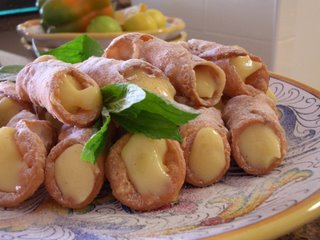Lime curd cannoli
 This started out with a net full of little Tahitian limes that were just on the verge of going a little yellow, so I wanted to use the juice and capture that last drop of summer limes before heading into winter. Lime curd is a great way to use lime juice.
This started out with a net full of little Tahitian limes that were just on the verge of going a little yellow, so I wanted to use the juice and capture that last drop of summer limes before heading into winter. Lime curd is a great way to use lime juice.125 grams butter
250 mls fresh lime juice
125 grams caster sugar
6 eggs
Melt the butter in a saucepan on a medium to high heat, add the sugar and lime juice, and stir to combine. Add the eggs and whisk until the mixture is thick like a custard. Contrary to popular opinion (and according to Stephanie Alexander who I trust implicitly) you can do this over a fairly high heat without risk of it splitting, as long as you whisk it and don’t leave it alone on the heat.
 The benefit of doing this is that all the zesty, fruity taste of the lime is retained without risk of dulling it through too long a cooking time. Another tip, that I picked up somewhere throughout my cooking adventures, is that the beauty of citrus curd is its silky, roll-around-the-mouth, smoothness. To make sure your curd is velvety and lumpless, strain the lime juice through a fine sieve and also strain the eggs (after lightly whisking them) through a fine sieve before adding them to the pan. This removes any coagulated bits of albumin in the whites and ensures a winning texture. Once cooked, allow to cool and refrigerate until you need it.
The benefit of doing this is that all the zesty, fruity taste of the lime is retained without risk of dulling it through too long a cooking time. Another tip, that I picked up somewhere throughout my cooking adventures, is that the beauty of citrus curd is its silky, roll-around-the-mouth, smoothness. To make sure your curd is velvety and lumpless, strain the lime juice through a fine sieve and also strain the eggs (after lightly whisking them) through a fine sieve before adding them to the pan. This removes any coagulated bits of albumin in the whites and ensures a winning texture. Once cooked, allow to cool and refrigerate until you need it.You can do heaps of things with curd. Tart fillings, cement biscuits together etc etc. But while I was shopping at the Zanetti 5 Star Deli (108 Ramsay Rd.) at Haberfield the other day, I saw packets of pre-made cannoli shells in normal and mini size ($4.99 for 20, made locally). Bingo. The vision of a plate full of baby cannoli filled with zingy lime curd accompanied by a rich Neapolitan espresso (Café Kimbo $4.99 for 250 grams) slid through my mind. Ain’t it great when inspiration hits like that?
 Cannoli (the plural of the Italian word cannolo or ‘tube’) originated in Sicily, probably at the time of Arab domination, but have pretty well spread throughout Italy as a Passticeria staple. They consist of a piece of pastry shaped around a metal tube and deep fried. They are usually filled with sweetened or flavoured ricotta. It’s important to fill them close to eating time so the shell stays crisp and crunchy - use a piping bag or a plastic bag with a tip cut into one corner to fill them easily and quickly. Although this version is not at all traditional, they went fabulously well with coffee and the entire plate full was consumed with gusto!
Cannoli (the plural of the Italian word cannolo or ‘tube’) originated in Sicily, probably at the time of Arab domination, but have pretty well spread throughout Italy as a Passticeria staple. They consist of a piece of pastry shaped around a metal tube and deep fried. They are usually filled with sweetened or flavoured ricotta. It’s important to fill them close to eating time so the shell stays crisp and crunchy - use a piping bag or a plastic bag with a tip cut into one corner to fill them easily and quickly. Although this version is not at all traditional, they went fabulously well with coffee and the entire plate full was consumed with gusto!





3 Comments:
yum, I was just about to ask how difficult the canoli shells were to make when I saw you bought them, never knew you could, will have to look out for some in Melbourne as sounds much easier than baking ones own
oooh these look so good.
i love zanetti 5 * deli... and have been eye balling these at other deli's for a while. i always wonder about their freshness. glad to see someone gave them a go - perhaps i will too :)
I know I'm a fan of slow cooking, but doing your own cannoli is pretty difficult. These ones were good, Ange and Deborah - very crunchy and crisp, held up well with filling, and they tasted just like one's you buy in the Passticceria. Unfortunately I chucked the wrapper so I can't tell you the brand, but I'll make a note next time I'm there. I'm sure you could get them in Melbourne too.
Post a Comment
<< Home